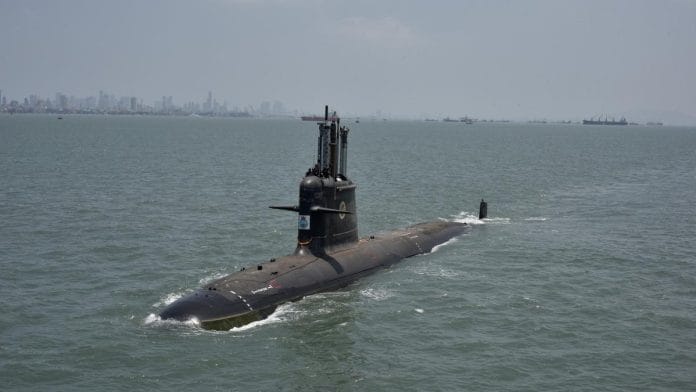New Delhi: The Indian Navy is in the final stages of finalising the field evaluation trial (FET) report in connection with the much-anticipated Project 75 India (P75I), under which six new conventional diesel-electric submarines with proven Air Independent Propulsion Systems (AIP) will get added to the fleet.
Sources in the defence and security establishments told ThePrint that the naval headquarters will send their recommendation to the defence ministry this month.
The Navy is all set to recommend the joint bid of the state-run Indian shipyard, Mazagon Dock Shipbuilders Limited (MDL), and the German naval giant, ThyssenKrupp Marine Systems of Germany (TKMS), to manufacture the diesel-electric submarines in India, ThePrint has learnt.
The move follows the FET carried out by a team of the Indian Navy, which visited shipyards in Germany and Spain based on the bids submitted.
Following the defence ministry nod, the Indian Navy will form a cost negotiation committee and is looking to sign the contract for the submarines in a year.
The Indian Navy’s choice of the MDL-TKMS offer is set to come just ahead of German Chancellor Olaf Scholz’s upcoming visit to India in October next month.
The submarine deal will figure high up in the inter-governmental consultations because, in this case, Germany wants to go in for a government-to-government contract.
However, sources said there would be no agreement inked then, but the German side will get updates about the progress on the Indian side.
Also Read: During Modi’s Singapore visit, India to lay emphasis on cooperation in semiconductor sector
Why TKMS and MDL are ahead
Sources in the defence establishment explained to ThePrint that P75I is the pioneering case that will progress under the strategic partnership model. Two shortlisted Indian applicant companies—MDL and Larsen & Toubro, India, received the request for proposal (RFP) for it.
They said that both the bidders submitted their compliance to the requirements as stipulated in the RFP in collaboration with their respective foreign collaborators, TKMS and Navantia, respectively.
The RFP stipulates the requirement of undertaking the FET of the AIP onboard a naval submarine at sea. Accordingly, the FET of the AIPs proposed by the foreign collaborators happened.
However, while the Germans proved their AIP on board a submarine, the Spanish could not because their first submarine with AIP will likely be operational only sometime in 2026.
“The requirement of FET of the AIP at sea had been enunciated clearly in the Expression of Interest Issued earlier in 2019 as also In the RFI Issued in 2007,” a source said.
Sources added that the requirement of a sea-proven AIP assumes significance since, unless sea-proven, safe and reliable for its designed functionality, the AIP system will expose the programme to significant technical and operational risks, cost and time overruns, and numerous challenges linked to integration.
The state-of-the-art proven fuel-cell AIP system, which will work in tandem with lithium-ion batteries, is one of the main demands of the Indian Navy.
The submarine is also supposed to have higher stealth features, which means that its design could be different from the ones currently operated by the Indian Navy.
The foreign company is supposed to hand over the submarine design to the Indian Navy.
The first submarine under P75I should be delivered seven years from the date of the contract signing. So, even if a contract gets signed tomorrow, the first submarine will come only by 2031 earliest.
The first submarine should have 45 percent of indigenous content, which is supposed to go up to 60 percent by the fourth submarine.
After the delivery of the first submarine, one submarine each is to be delivered every year.
Also Read: Mega aircraft deal in sight, TATA-Lockheed Martin to set up C-130 MRO base in India for IAF, others
India’s long-delayed 30-year-submarine programme
The P75I project is part of a 30-year submarine-building plan that ends in 2030. Under this plan, India earlier planned to build 24 conventional submarines. However, subsequently, the plan changed under the Narendra Modi government. Now, the plan constitutes building 18 conventional submarines and six nuclear-powered submarines (SSNs) to work as an effective deterrent against China and Pakistan.
Under the plan, two separate submarine lines will be built with foreign collaboration—followed by an indigenous project, with the learnings from the earlier two programmes for another 12.
Since envisaging the plan in 1998, India has managed to induct only five conventional submarines and will induct the sixth under Project 75 later this year.
India currently operates 16 conventional submarines, including five Scorpene class (French), four Howaldtswerke-Deutsche Werft (German) and seven Kilo-class (Russian).
While India will eventually operate 17 conventional submarines next year, sources pointed out that this would only be on paper. The main thing, they said, is operational availability. The Scorpene submarines are brand new, so their availability ratio is much higher.
Next are the German HDWs, which continue to be the most reliable and high on performance. “These submarines will last us another 10-15 years,” a source earlier said, explaining the issues the Indian Navy continues to face with its submarine fleet.
India had 10 Kilo-class submarines initially. Currently, only seven remain. The Kilos are rated very good, but their availability ratio is down. They have undergone upgrades but will not be able to last as long as the HDWs, said the sources, adding that this is because most were commissioned early in the 1980s, with one already decommissioned.
(Edited by Madhurita Goswami)






